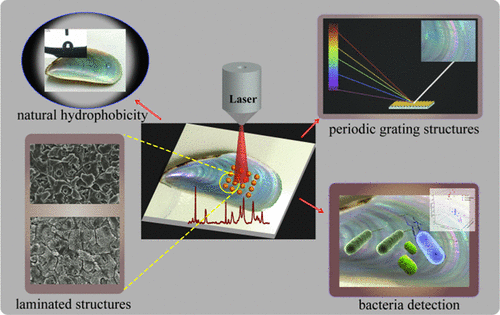Our official English website, www.x-mol.net, welcomes your
feedback! (Note: you will need to create a separate account there.)
Self-Assembly of Au@Ag Nanoparticles on Mussel Shell To Form Large-Scale 3D Supercrystals as Natural SERS Substrates for the Detection of Pathogenic Bacteria.
ACS Omega ( IF 3.7 ) Pub Date : 2018-03-09 , DOI: 10.1021/acsomega.8b00023 Kaisong Yuan 1, 2 , Junxia Zheng 3 , Danting Yang 4 , Beatriz Jurado Sánchez 2, 5 , Xiangjiang Liu 6 , Xinjie Guo 1 , Chusheng Liu 1 , Nicoleta Elena Dina 7 , Jingyi Jian 1 , Zhijun Bao 1 , Ziwei Hu 1 , Zhihong Liang 8 , Haibo Zhou 1 , Zhengjin Jiang 1
ACS Omega ( IF 3.7 ) Pub Date : 2018-03-09 , DOI: 10.1021/acsomega.8b00023 Kaisong Yuan 1, 2 , Junxia Zheng 3 , Danting Yang 4 , Beatriz Jurado Sánchez 2, 5 , Xiangjiang Liu 6 , Xinjie Guo 1 , Chusheng Liu 1 , Nicoleta Elena Dina 7 , Jingyi Jian 1 , Zhijun Bao 1 , Ziwei Hu 1 , Zhihong Liang 8 , Haibo Zhou 1 , Zhengjin Jiang 1
Affiliation

|
Herein, we developed a natural surface-enhanced Raman scattering (SERS) substrate based on size-tunable Au@Ag nanoparticle-coated mussel shell to form large-scale three-dimensional (3D) supercrystals (up to 10 cm2) that exhibit surface-laminated structures and crossed nanoplates and nanochannels. The high content of CaCO3 in the mussel shell results in superior hydrophobicity for analyte enrichment, and the crossed nanoplates and nanochannels provided rich SERS hot spots, which together lead to high sensitivity. Finite-difference time-domain simulations showed that nanoparticles in the channels exhibit apparently a higher electromagnetic field enhancement than nanoparticles on the platelets. Thus, under optimized conditions (using Au@AgNPs with 5 nm shell thickness), highly sensitive SERS detection with a detection limit as low as 10-9 M for rhodamine 6G was obtained. Moreover, the maximum electromagnetic field enhancement of different types of 3D supercrystals shows no apparent difference, and Au@AgNPs were uniformly distributed such that reproducible SERS measurements with a 6.5% variation (613 cm-1 peak) over 20 spectra were achieved. More importantly, the as-prepared SERS substrates can be utilized for the fast discrimination of Escherichia coli, Staphylococcus aureus, and Pseudomonas aeruginosa by discriminant analysis. This novel Au@Ag self-assembled mussel shell template holds considerable promise as low-cost, durable, sensitive, and reproducible substrates for future SERS-based biosensors.
中文翻译:

Au@Ag 纳米粒子在贻贝壳上自组装形成大规模 3D 超晶体作为天然 SERS 底物用于检测致病细菌。
在此,我们开发了一种基于尺寸可调的 Au@Ag 纳米颗粒涂层贻贝壳的天然表面增强拉曼散射 (SERS) 基底,以形成大规模三维 (3D) 超晶体(高达 10 cm2),该超晶体表现出表面-层状结构和交叉的纳米板和纳米通道。贻贝壳中高含量的 CaCO3 为分析物富集提供了优异的疏水性,交叉的纳米板和纳米通道提供了丰富的 SERS 热点,这些共同导致了高灵敏度。有限差分时域模拟表明,通道中的纳米颗粒表现出明显比血小板上的纳米颗粒更高的电磁场增强。因此,在优化条件下(使用壳厚度为5 nm的Au@AgNPs),获得了高灵敏度的SERS检测,对罗丹明6G的检测限低至10-9 M。此外,不同类型的3D超晶的最大电磁场增强没有明显差异,并且Au@AgNPs均匀分布,从而在20个光谱上实现了具有6.5%变化(613 cm-1峰值)的可重复SERS测量。更重要的是,所制备的SERS底物可用于通过判别分析快速区分大肠杆菌、金黄色葡萄球菌和铜绿假单胞菌。这种新型 Au@Ag 自组装贻贝壳模板作为未来基于 SERS 的生物传感器的低成本、耐用、敏感和可重复的基材具有广阔的前景。
更新日期:2018-03-09
中文翻译:

Au@Ag 纳米粒子在贻贝壳上自组装形成大规模 3D 超晶体作为天然 SERS 底物用于检测致病细菌。
在此,我们开发了一种基于尺寸可调的 Au@Ag 纳米颗粒涂层贻贝壳的天然表面增强拉曼散射 (SERS) 基底,以形成大规模三维 (3D) 超晶体(高达 10 cm2),该超晶体表现出表面-层状结构和交叉的纳米板和纳米通道。贻贝壳中高含量的 CaCO3 为分析物富集提供了优异的疏水性,交叉的纳米板和纳米通道提供了丰富的 SERS 热点,这些共同导致了高灵敏度。有限差分时域模拟表明,通道中的纳米颗粒表现出明显比血小板上的纳米颗粒更高的电磁场增强。因此,在优化条件下(使用壳厚度为5 nm的Au@AgNPs),获得了高灵敏度的SERS检测,对罗丹明6G的检测限低至10-9 M。此外,不同类型的3D超晶的最大电磁场增强没有明显差异,并且Au@AgNPs均匀分布,从而在20个光谱上实现了具有6.5%变化(613 cm-1峰值)的可重复SERS测量。更重要的是,所制备的SERS底物可用于通过判别分析快速区分大肠杆菌、金黄色葡萄球菌和铜绿假单胞菌。这种新型 Au@Ag 自组装贻贝壳模板作为未来基于 SERS 的生物传感器的低成本、耐用、敏感和可重复的基材具有广阔的前景。











































 京公网安备 11010802027423号
京公网安备 11010802027423号